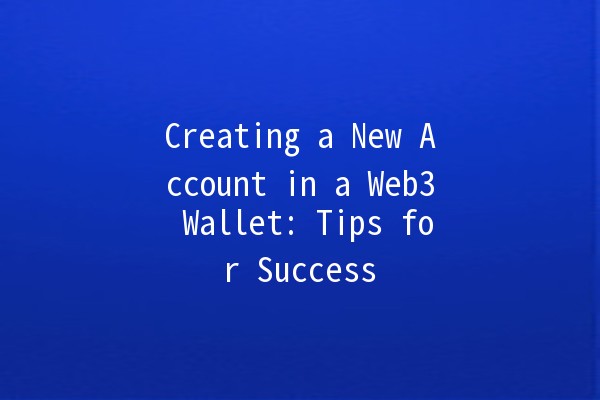
As the world transitions toward decentralization, understanding how to create a new account in a Web3 wallet becomes increasingly essential. This article provides practical tips for effectively setting up your Web3 wallet account while incorporating necessary productivityenhancing strategies.
What is a Web3 Wallet?

A Web3 wallet is a digital wallet that allows users to manage their cryptocurrencies, NFTs, and interact with decentralized applications (DApps). Unlike traditional wallets, Web3 wallets operate on the blockchain, giving users more control over their digital assets. Understanding the unique features of Web3 wallets will help you navigate this decentralized landscape successfully.
Why Create a Web3 Wallet Account?
Key Considerations Before Creating an Account
Before diving into the creation process, consider the following:
Choosing the Right Wallet: Identify a wallet that meets your needs based on features like security, usability, and compatibility with various blockchains.
Security: Establish robust security measures to protect your assets, like using hardware wallets or enabling twofactor authentication (2FA).
Steps to Create Your Web3 Wallet Account
Creating a Web3 wallet account is straightforward, yet it requires careful attention to detail. Here’s how to do it, along with five productivityboosting tips:
Explanation:
Choosing the appropriate wallet forms the foundation of a successful Web3 experience. Look for wallets that are widely used, wellrated, and offer responsive customer support.
Application Example:
MetaMask: A popular option compatible with both Ethereum and Binance Smart Chain, offering ease of use and integration with many DApps.
Trust Wallet: A mobile wallet that provides a userfriendly interface with support for various cryptocurrencies and tokens.
Explanation:
After selecting a wallet, download the corresponding application or browser extension. Ensure that you're only downloading from official websites or app stores to avoid phishing scams.
Application Example:
If you choose MetaMask, visit the official MetaMask website or the Chrome Web Store to download the extension, making sure to check for verification.
Explanation:
Once you have the wallet application, open it and start setting up your account.
Tips for Productivity:
Save Your Seed Phrase: Upon creation, the wallet generates a seed phrase. Write this down and store it in a safe location. This phrase is your backup.
Utilize Password Managers: Consider using a password manager to store your wallet credentials securely.
Application Example:
When creating an account on MetaMask, you'll be prompted to create a strong password and back up your seed phrase. Store these securely in your password manager.
Explanation:
Fund your wallet to start participating in the Web3 ecosystem. You can do this by buying cryptocurrencies/exchanges or receiving them from another wallet.
Application Example:
If you need Ethereum, use an exchange like Coinbase or Binance to purchase and send it to your new MetaMask wallet address.
Explanation:
With your wallet set up and funded, you can now interact with various DApps and utilize features such as staking, lending, and trading.
Productivity Tips:
Utilize tools like IFTTT or Zapier to automate processes related to transaction recordkeeping or alerts on crypto price changes. For example, set an automation to notify you when a specific cryptocurrency reaches your desired price.
Set up a personal dashboard using tools like Google Sheets or Notion to track your crypto portfolio’s performance. Include metrics that matter most to you, such as current value, purchase date, and percentage gain.
Set periodic calendar reminders to review your wallet security settings and the performance of your investments. This practice ensures you stay updated on critical changes in the cryptocurrency market.
Engage with crypto online communities on platforms like Reddit or Discord. These forums can provide insights, support, and timely information about the latest trends in Web
5. Continuous Education 📘
Stay educated about crypto trends, wallet security practices, and new DApps. Websites like CoinDesk and CoinTelegraph can provide ongoing updates that empower informed decisionmaking.
Common Questions
Losing your seed phrase can result in permanent loss of access to your wallet and assets. It's crucial to back it up in a secure offline location. If someone else gains access to this phrase, they can control your wallet.
Yes! Many users opt for multiple wallets tailored to specific currencies or purposes. Diversifying where you store your assets can enhance security and flexibility.
Implement various security measures including strong passwords, enabling 2FA where available, and considering hardware wallets for larger amounts. Regularly update your wallet application to benefit from improved security features.
Most Web3 wallets do not charge fees for creating an account; however, transaction fees (also known as gas fees) may apply when interacting with the blockchain. Ensure you understand these costs when transferring assets.
If your wallet is accessible via seed phrase, you can restore it on another device. Always back up this information in a secure, offline location to prevent data loss.
If you forget your wallet password but have your seed phrase, you can reset your wallet on a new device. Always keep your seed phrase secure to mitigate the risk of losing access.
Creating a new account in a Web3 wallet is essential for anyone wishing to navigate the decentralized landscape of cryptocurrencies and DApps. By selecting a reliable wallet, practicing security measures, and employing productivityenhancing strategies, users can ensure a successful experience in the everevolving Web3 world. Remember, the keys to success in this decentralized space are knowledge, preparation, and an unwavering commitment to security.

